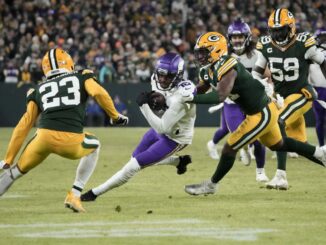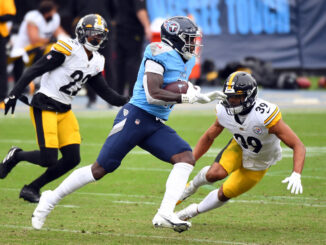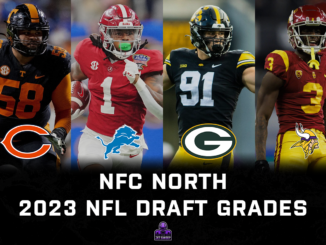
With the offseason now in full swing, teams will be turning their attention to the start of the new league year on March 15th. As part of that process, all 32 teams will need to ensure that they are under the cap before that date. For some teams that will mean making some tough decisions along the way.
The Vikings are one of those teams. As things stand they are $24.4m over the cap, the third highest mark in the entire NFL. They will no doubt look to cut a few players – the question is who? Here are five possible cut candidates for the Vikings this offseason
Adam Thielen
Pre-June 1 cut: $6.4m in savings
Post-June 1 cut: $13.4m in savings
Thielen has been one of the pillars of the Vikings offense through recent years, but it feels like he may have played his last game for the team. The former All-Pro is set to turn 33 over the course of the offseason and it looked like he was beginning to decline last season. He was also overtaken by TJ Hockenson as the team’s secondary option in the passing game.
His 716 yards in 2022 was his lowest single season total (not counting an injury-shortened 2019) since he became a starter all the way back in 2016. With that in mind, his 2023 cap hit of $19.9m certainly feels a little steep. In an ideal world they would wait to make him a post-June 1 cut to double their savings, but in order to get under the cap his release might happen sooner than that.
Harrison Smith
Pre-June 1 cut: $7.37m in savings
Post-June 1 cut: $15.2m in savings
In many ways, Smith is the defensive equivalent of Thielen – a player who has been a backbone of the franchise but who is also getting older and earning some huge money that their tape doesn’t quite justify anymore. Smith is set to earn $19.1m in 2023, the most of any defensive player on the Vikings roster. That figure also makes him the second highest paid safety in the NFL next season.
Cutting a 34-year old Smith has the potential to generate the most cap space of any player on this list. As with Thielen, the temptation to wait and make him a post-June 1 cut is there, but they may not have that luxury. Regardless, they can’t afford to allocate this kind of money to a declining veteran.
Dalvin Cook
Pre-June 1 cut: $5.9m in savings
Post-June 1 cut: $9m in savings
This one is admittedly a tricky one. If any player on this list offers legitimate trade value it is Cook. After all, he’s coming off the back of his fourth consecutive 1,000+ yard season. The Vikings might want to keep Cook on the roster until the new league year starts and then trade him for some draft capital that they can use to retool their roster.
That said, if the market doesn’t materialise then cutting him is probably the right answer. Cook turns 28 this offseason, which tends to be the point at which running back production declines. He also counts $14.1m against the cap, which is a significant sum of money for the position. With a deep rookie running back class on the horizon the Vikings should be able to secure a replacement for a substantial financial saving.
Eric Kendricks
Pre-June 1 cut: $9.5m in savings
Post-June 1 cut: $9.5m in savings
Kendricks has been a big part of Minnesota’s defense since he was drafted in the second round back in 2015. That said, he appeared to take a bit of a step back in 2022, which is perhaps not entirely surprising for a 30-year old linebacker. Whilst he can no doubt still add value, the question is whether he can justify his $11.4m cap hit.
The Vikings would save a solid $9.5m in cap space by cutting Kendricks, accounting for almost half of their entire cap overspend. They also picked Oklahoma linebacker Brian Asamoah in the third round last year and he looked good in limited snaps as a rookie. It is always tough to cut long-serving veterans, but this feels like a sensible move.
CJ Ham
Pre-June 1 cut: $3.05m in savings
Post-June 1 cut: $3.05m in savings
Ham is a good fullback, but with cap looking tight he might be seen as expendable. After all, he played just 14.5% of the Vikings’ offensive snaps in 2022. That is comfortably the lowest snap rate of any player on this list. It’s also not particularly high even by fullback standards, ranking 10th of 18 players at the position. The $3.05m in savings isn’t huge, but it can help them to be cap compliant before the start of the league year, and that counts for something.


